You Can Help These Good Bills Get Passed
With a month left in the 87th session of the Texas Legislature, the time is ripe to work together to give these great bills the push they need to pass.
Bill would enable TPWD to protect water quality
We are really excited to have HB 2716 by Representative Tracy King is set for a vote by the Texas House this Monday (5/3 at 10:am). This bill would restore to Texas Parks and Wildlife Department (TPWD) the authority contest water rights permits and pollution discharge permits issued by the Texas Commission on Environmental Quality (TCEQ) if such permits might adversely affect state parks and wildlife management areas or the fish and wildlife managed by the agency. It has been very frustrating that TPWD was not able to join GEAA to fight the waste water permit that threatened to pollute the spring-fed Honey Creek and the Honey Creek State Natural Area.
While GEAA and our partners have negotiated a settlement agreement with the developers of Honey Creek Ranch MUD that address many of our issues (stay tuned for more on that later), next time, the outcome might be different unless Parks and Wildlife is once again given the authority to protect the public’s properties and the public’s fish and wildlife. See GEAA’s Comments in Support of HB 2716.
Bill would increase TCEQ transparency
Also set for a vote by the Texas House on Monday is HB 2990 by Representative Morales-Shaw, which would require TCEQ to make certain environmental and water use permit applications available online. Any of you who have worked with us on these issues know what a great help this would be.
By Monday - Please contact your state representative and urge them to vote AYE! on HB 2716 and HB 2990. All state reps can be emailed at firstname.lastname@house.texas.gov.
Bill would protect Hill Country streams
One of our favorite bills of this session, HB 4146 by Representative Tracy King - which would prohibit direct discharge of waste water effluent into our pristine Hill Country streams - was sent to the Calendars Committee on April 28th to be scheduled for a vote. See GEAA’s Comments in Support of HB 4146.
We need two actions from you to get this legislation to the finish line:
- Please contact the chair of the House Calendar Committee, Representative Dustin Burrows (dustin.burrows@house.texas.gov) and request that he forward HB 4146 for a vote of the House.
- Contact Lt. Governor Dan Patrick to request that the Senate Committee on Water, Agriculture, and Rural Affairs schedule a vote on companion bill SB 1747 by Senator Zaffirini ASAP. Lieutenant Governor Dan Patrick – phone 512-463-5342 | dan.patrick@ltgov.texas.gov | https://www.ltgov.texas.gov/contact/
Bill would preserve instream flows
HB 2225 by Representative Tracy King directs Texas Parks and Wildlife Department to take an active role in expanding the use of the Texas Water Trust to preserve instream flows in the state’s rivers and freshwater inflows to our productive coastal bays and estuaries. These “environmental flows” are critical to maintaining healthy populations of fish and wildlife that depend on that water.
Such flows also enhance water quality and provide recreational opportunities enjoyed by millions of Texans and visitors to our state. See GEAA’s Comments in Support of HB 2225.
HB 2225 passed the House in April on a vote of 138 to 10. The bill is now in the Senate, where the legislation is being carried by State Senator Judith Zaffirini. HB 2225 has been referred to the Senate Committee on Water, Agriculture & Rural Affairs and is expected to be heard in that Committee shortly.
Although the bill is popular, time is running short If you are a fan of flowing rivers, fish and wildlife, and our state’s bountiful coastal resources, call and/or email your state senator NOW and ask them to help get HB 2225 to the Senate floor and passed. All state senators can be emailed at firstname.lastname@senate.texas.gov.
by Annalisa Peace, Executive Director, Greater Edwards Aquifer AllianceLegislation Threatens Local Environmental Protections
Hopefully you’re keeping up with the 2021 Texas Legislature through the Lone Star Chapter’s updates. In this article, I will focus on lesser-known legislation that doesn’t fit the “environmental bills” mold, yet still can have significant environmental impacts.
Because Texas’s large cities vote blue, and enforce ordinances to manage their community's environmental issues, they are frequently targeted by bills that interfere with their local control. In past sessions, we’ve seen bills that outlaw plastic bag bans and overturn ordinances prohibiting fracking near schools and homes.
This session is no different, with the usual array of bills that benefit out-of-state corporations and special interests at the expense of local democracies. For example, HB 2573 would nullify ordinances that protect water quality in streams and aquifers by limiting changes land developers can make to the natural topography. It was killed on a point-of-order last session, and doesn’t appear to be progressing quickly enough to pass this session.
Bills aim to deregulate land development industry
Another pair of bills, SB 1992/HB 3519, could be used by developers to clear-cut trees and ignore rules to protect the Edwards Aquifer. Moreover, they could amount to a substantial deregulation of the land development industry. Fortunately, both bills were left pending in committee with time for passage running short.
A dangerous pair of bills, SB 1922/HB 1885, are on the move with the Senate version already passed and the House version about to be scheduled for a floor vote. Although the bills seem written to deregulate billboards, their unusual drafting makes them “Trojan horses” that are easily subject to floor amendments that could make their environmental impact quite damaging.
Silencing the peoples' voices
SB 10 would make it difficult for cities and counties to lobby the Legislature. It is significant because city and county lobbyists are often the only people who speak at committee hearings to defend local environmental ordinances. If it passes, the voices of corporations and right-wing think tanks could drown out the voices of the people. SB 10 has already passed the Senate and was sent to the House Committee on State Affairs.
Criminalizing homelessness
Lastly, I’ll call your attention to a bill that would criminalize being homeless and make it harder for persons experiencing homelessness to access services and exit homelessness. It would also punish cities that allow homeless people to sleep in public spaces using blankets or a sleeping bag. Although the bill has drawn substantial opposition, it is still moving.
Please contact your state rep and senator and register your opposition to these bills.
by Richard Alles, Newsletter EditorMigratory Birds Driven out of City Parks
I have been fighting the City of San Antonio's Parks and Recreation Department (PARD) over the last few years in regards to the migratory birds at Brackenridge Park. PARD wants to get rid of migratory egrets and herons at city parks with no plans as to where the birds are expected to go once they've been driven out.
PARD has been destroying and modifying nesting habitat for these birds, and in doing so, has succeeded only in moving the perceived "problem" from one area to another. They now face the threat of the USDA being used to destroy the last nesting habitat in the city.
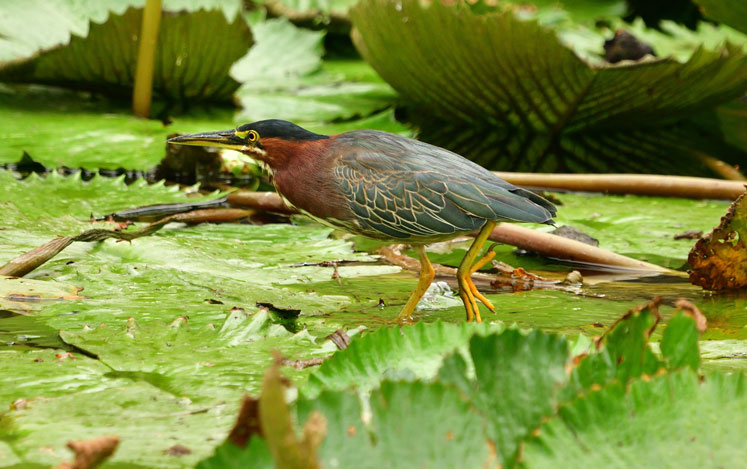
by Alesia Garlock
I have observed and documented the nesting of the birds for the last five years, including suffering through the pesticide sprayers used against the birds. Although the city made a proclamation, in December, to join the Bird City Texas program, PARD has different plans according to emails I obtained.
There are four species that nest at Brackenridge Park listed as Species of Greatest Conservation Need (SGCN). Texas receives federal funding mandated by Congress to keep these species from becoming threatened or endangered. Just how much is a SGCN worth to the State of Texas? Under the State's Wildlife Action plan the Apportionment for Texas between 2002-2019: $51,010,846.
So why would PARD allow the USDA to destroy nests or harass or even harm these species? Good question.
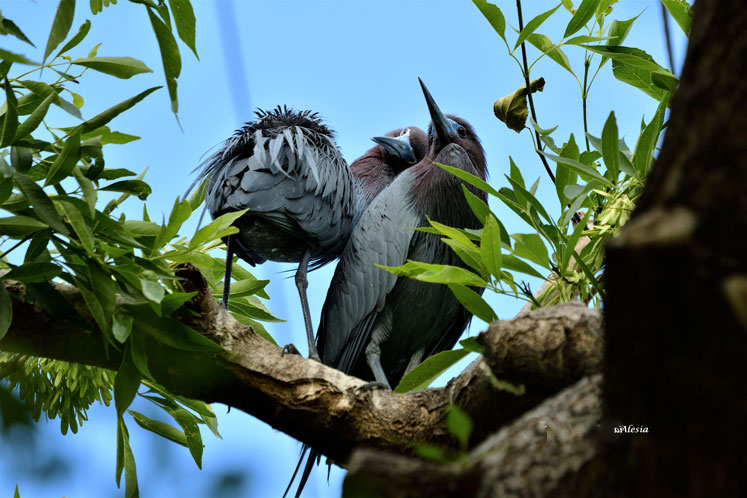
by Alesia Garlock
The habitats of waterbirds—the important sites on which they depend for nesting, feeding and wintering— are at risk due to human related and natural threats (Ref: North American Waterbird Conservation Plan (fws.gov)). Climate change is shrinking their range, and drying up their water sources.
These birds have nested in city parks for decades. If we want them to survive 20 years from now, we need to start taking care of them. Let's not squander this great opportunity for public engagement and education. We need to learn to coexist with the birds. If we don't, we all suffer.
Visit the Friends of the Migratory Birds in San Antonio Facebook page for more pictures of birds. In addition, check out this video about SGCN Species.
by Alesia Garlock, Alamo Group memberGrand Canyon National Park: Monument Point to the Esplanade
In June 2020 the park North Rim re-opened for day use, though all facilities were closed due to COVID-19. But DeMotte campground, in Kaibab National Forest just north of the park north entrance, was open. I refreshed my North Rim trails wish list and scrambled gear for another trip.
The park website says 277 miles of the Colorado River are included in the park. That is the background for the pile of interesting trails from or along the North Rim reached by driving through Kaibab NF, which pretty much is the Kaibab Plateau, or BLM lands west and east of the plateau.
For example the Bill Hall Trail from Monument Point down to the Esplanade, with a loop continuing past Thunder River (which is actually an enormous spring), down Tapeats Creek to the Colorado, along the river to Deer Creek and back. Hiking across the Esplanade is similar to traversing the Tonto Plateau below the South Rim.
The whole loop is 22 miles; I just did 10 miles total to a viewpoint on the Esplanade and back. This is the Esplanade sandstone, about 300 million years old.
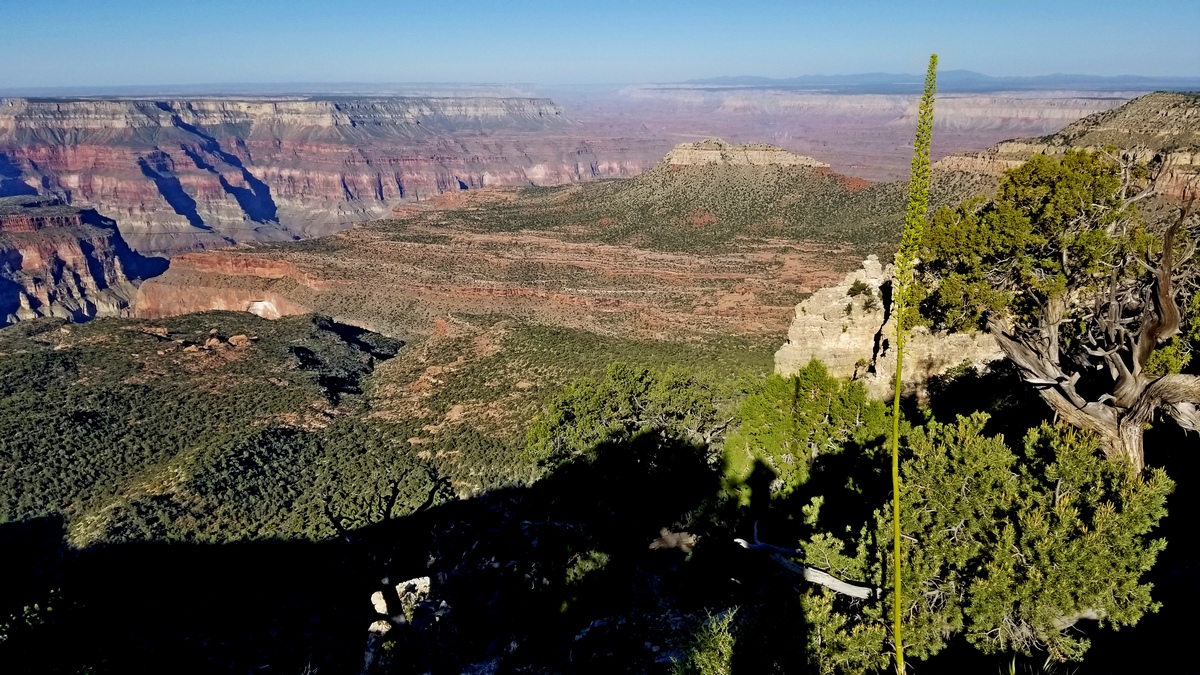
While I was assembling gear at the trailhead an NPS chopper landed and unloaded two backpackers evacuated from the loop route. The chopper returned for three more folks of the same group; the co-pilot stayed behind. He asked about my NOLS Wilderness Medicine car sticker, and told me they had run out of water and food and had called 911 on their sat phone. One of my hiking buddies earlier said she had done the loop when younger, and I was thinking of doing it but believe am a bit too old now, particularly for doing it solo.
A group of us backpacking along the Tonto Plateau (article in this newsletter May 2018) some years ago met a particular backcountry ranger twice at campgrounds. We learned she had traversed the national park below the North Rim, as did Colin Fletcher mostly below the South Rim in 1963 (gotta read his book The Man Who Walked Through Time). She did day hikes to cache supplies along the route ahead of time. Her route would have crossed the Esplanade on a trail section used for my dayhike. I found an article by people that did possibly much the same route.
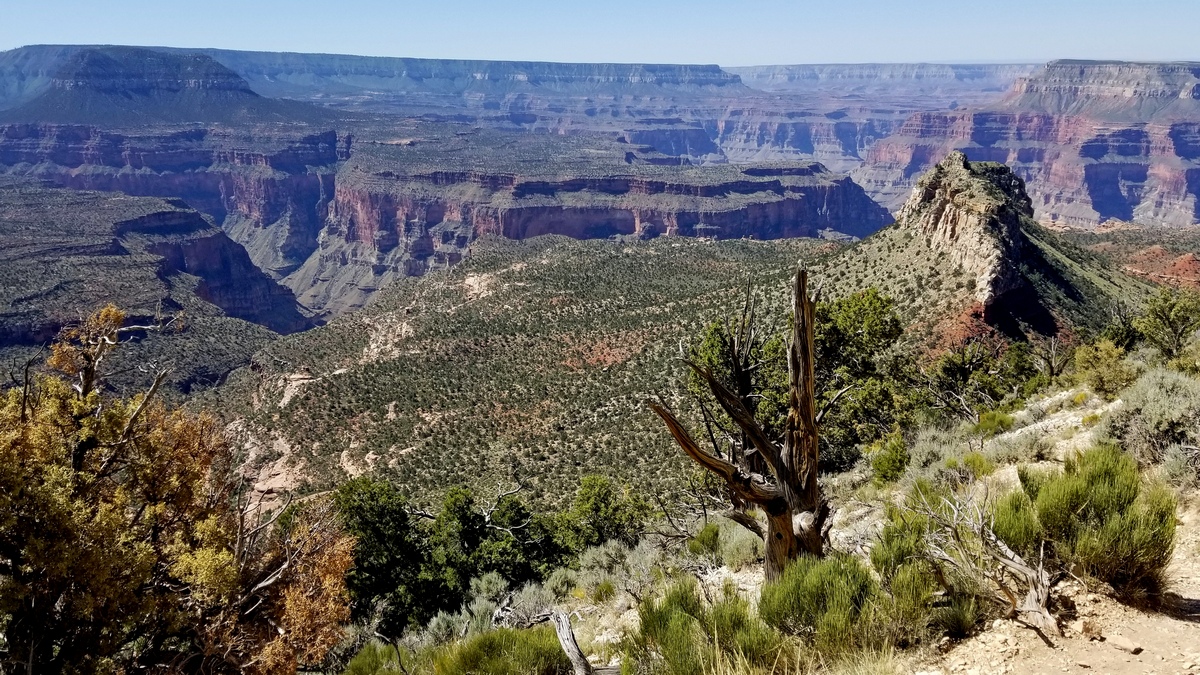
I like DeMotte campground; well managed, centrally located for driving to trails through the national forest, and less crowded than the national park campground. The vault toilets are spotless, possibly could do surgery in there. There is a gas station, store and food truck on AZ highway 67 opposite the entrance to DeMotte.
There are a zillion at-large campspots in the national forest close to the rim and the national park boundary. No facilities or water are available beyond DeMotte and the national park North Rim developed area. The latter is always closed October 15-May 15, but you can get to spots like Monument Point through the national forest, assuming there isn't much snow (and won't suddenly be) and the USFS roads have been cleared of deadfalls in the spring. Many roads are high clearance and even AWD, though the routes to popular spots are usually in reasonable shape (more or less).
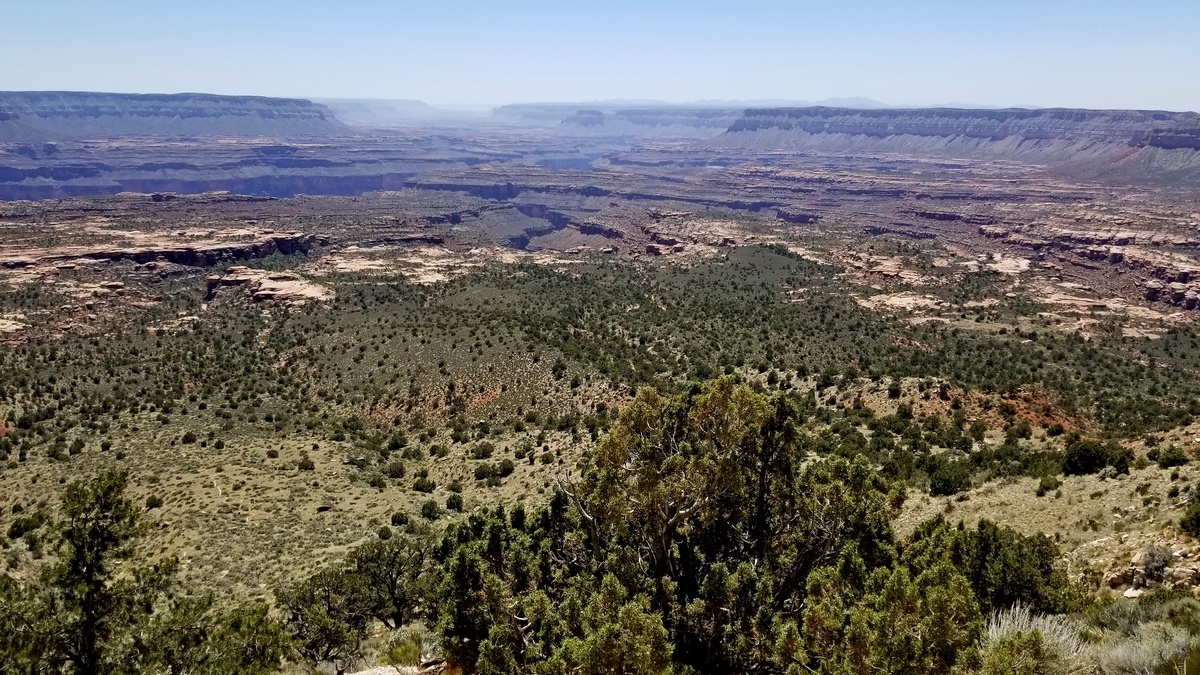
A pretty amazing day hike. I encountered only two other hikers en route. I found a web page with a picture taken just to the left of the one below, highlighting a very large sandstone blob and suggesting it is a petrified alien spaceship.
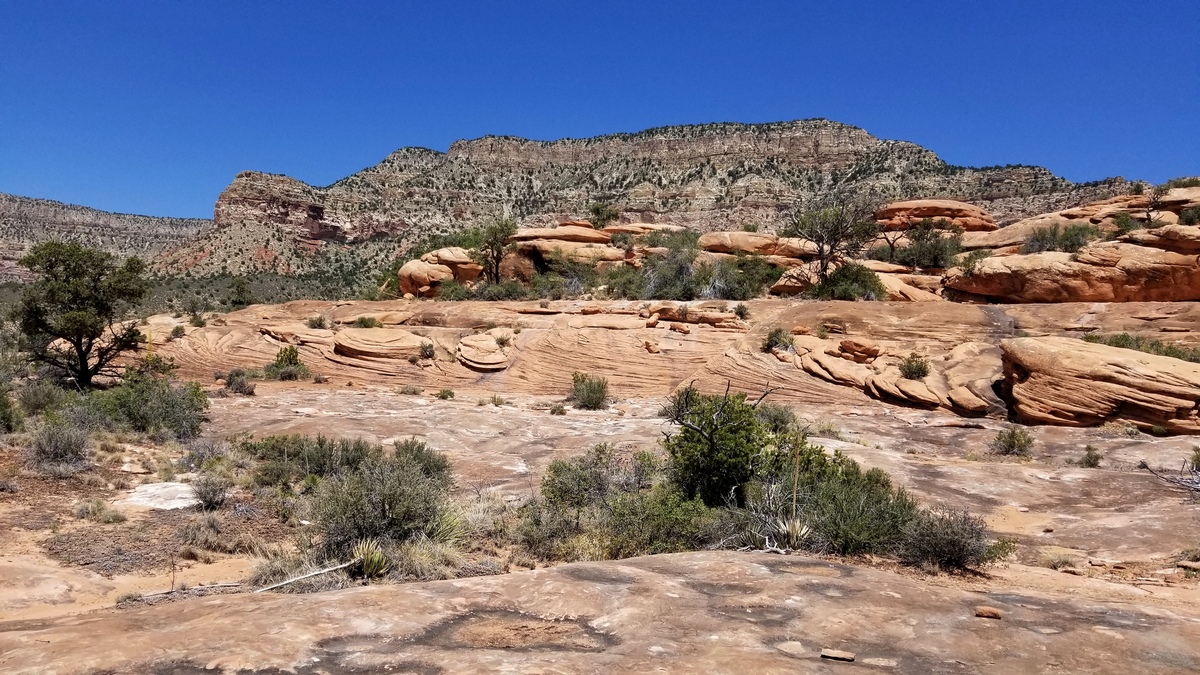
From the e-Mailbag
From time-to-time, the Alamo Group receives messages concerning local environmental issues. If you have thoughts to share on any of these issues, send me a message and I'll forward them to the writer.
Newspapers are polluting our neighborhoods
The Herald news paper is seriously polluting our neighborhoods and water ways. These papers are ending up in streets and are being run over and turned into fine particles of plastic and paper,which are blown or washed down into storm drains. They are being turned into confetti by lawn mowers that could care less about trash, then it all takes flight in a high wind.
Please help us put pressure on this nuisance because they are seriously polluting our suburbs with paper and plastic bags.I can count a dozen old papers on my block alone, that's one block in one small city, please do the math and help us end this environmental nightmare. In this day and age of electronic media this shouldn't be happening! Thank you!
from Tom B.
Prue Road tree massacre
Prue Road construction project: Hundreds of mature trees are set to be destroyed along Prue Road in the very near future. Aside from the loss of so many beautiful trees, I believe it is possible the city will not give any regard to approaching nesting season.
This will be tragic for many species of birds. I have contacted two other sources. There seems to be a pass the buck attitude with this but the Audubon Society referred me to you.
from Marilyn B.
What happened to my hummingbirds?
I am an active member of the Sierra Club. I am a bird watcher. I live in the Hill Country on acerage.
I usually have 20+ hummingbirds. This has been a steady flock for the last 23 years. They are usually here fir the entire season, from March to October. This is the first year I am seeing only a handful of hummingbirds.
Has their habitat been compromised in Mexico or South ? Is it the drought? I’d anyone else observing the dramatic drop in hummingbird populations? Please advise and thank you.
from Raje W.
Water management for everyday people
Hello, I was hoping to get some more information about ways we can help water management as a everyday person or spread awareness of it.
from Jime B.
by Richard Alles, Newsletter EditorNew on the Bookshelf
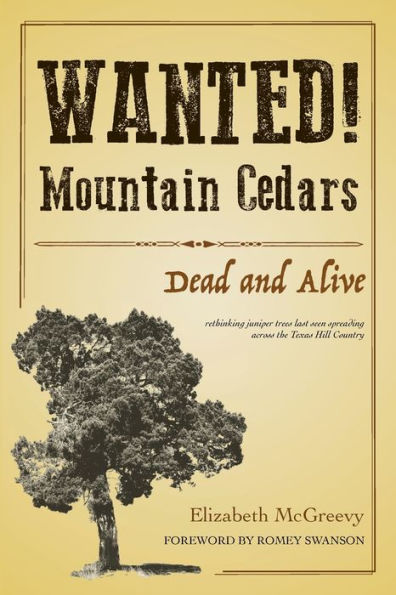
Wanted! Mountain Cedars, Dead and Alive tells the story of Mountain Cedar trees that grow in the Texas Hill Country. Over the last 100 years, these trees have been characterized as non-native, water-hogging, grass-killing, toxic, useless species to justify their removal. The result has been a glut of Mountain Cedar tall tales and anti-cedar sentiments.
Inside this ambitious, well-researched book, natural resources consultant and ecologist Elizabeth McGreevy presents another perspective of these trees, also known as Ashe Junipers or Blueberry Junipers. While digging into Texas Hill Country politics, history, economics, culture, and ecology, McGreevy tracks down the origins of each tall tale to determine what is true, what is false, and what lies somewhere in between.
She also explains why people respected Mountain Cedars before the 1900s, and what events led to the trees' downfall and the landscape we see today. Through a series of arguments, this book serves to replace anti-cedar sentiments with a more constructive, less emotional approach to Hill Country land management and a perspective that not all Mountain Cedars are bad. McGreevy's book is available from Barnes & Noble.
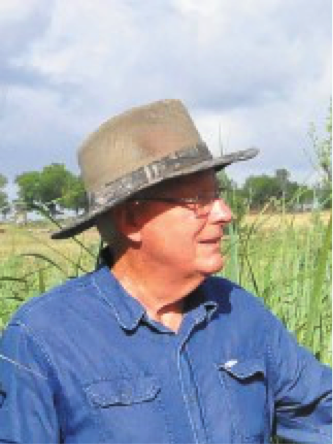
How We Are Restoring a Tall Grass Blackland Prairie
Our May General Meeting on Zoom features Don Kirchoff from the Kirchoff Family Farm, LLC.
Tuesday, May 18th
6:00 p.m.
Online via Zoom
Mr. Kirchoff will discuss his project restoring 200 acres of dryland farm in Wilson County back to the tall grass Blackland prairie it once was. For details, visit our event page and contact Joan Cunningham.

Outings: The Call of the Wild
Visit the Alamo Sierra Club Outings page on Meetup for detailed information about all of our upcoming Sierra Club Outings.
The Alamo Sierran Newsletter
Richard Alles, Editor
Published by The Alamo Group of the Sierra Club, P.O. Box 6443, San Antonio, TX 78209, AlamoSierraClub.org.
The Alamo Group is one of 13 regional groups within the Lone Star Chapter of the Sierra Club.
Changed your contact information?
If you're not sure whether the Sierra Club has your current email address, send an email to Member Services with your name and address and/or member ID (see Locating Your Member ID) so they can add your email address to your member record.
Have you moved? Let us know by sending your old address, your new address and your member ID to: address.changes@sierraclub.org.
Go online for the latest news and events
 |